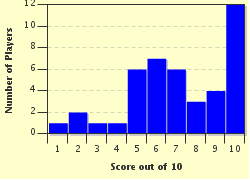Quiz Answer Key and Fun Facts
1. Cressida is an inner satellite of Uranus and its name is taken from which play by William Shakespeare?
2. The moon Galatea takes its name from a Greek sea nymph. Knowing that, which planet does it more likely orbit?
3. Himalia is the largest moon of the Himalia Group of Jupiter's satellites.
Since its name ends in -a, it has a prograde orbit (it orbits Jupiter in the same direction as the planet orbits the Sun).
4. Skathi is one of Saturn's moons which does not take its name from Greek or Roman mythology. Which mythology does it take its name from?
5. The mythological Lysithea was a daughter of Oceanus and a lover of Zeus. A satellite of which planet has taken her name?
6. Pallene is one of the three natural satellites, called Alkyonides, which are found between the orbits of larger moons Mimas and Enceladus. Which planet do they all orbit?
7. This satellite of Uranus was first discovered in 1999, in pictures taken by Voyager 2. It was demoted in 2001 only to be finally confirmed as a satellite in 2003 from pictures taken by Hubble Space Telescope. It was named after which female character, whose name means "lost" in Latin, from Shakespeare's "The Winter's Tale"?
8. Psamathe is a small outer satellite of Neptune that is so distant from the planet, its orbit takes 26 Earth years to complete. According to NASA, how big is its diameter?
9. Telesto is a tiny moon in the complex system of Saturn's natural satellites. In 2005, the Cassini spacecraft photographed Telesto's surface and discovered that it was heavily scarred with impact craters.
10. Mond, masina, hold, selene, inyanga, candra are names of this lonely moon in different languages. It is lonely because it is an only child of the planet it orbits. Which moon is it?
Source: Author
tiye
This quiz was reviewed by FunTrivia editor
rossian before going online.
Any errors found in FunTrivia content are routinely corrected through our feedback system.

